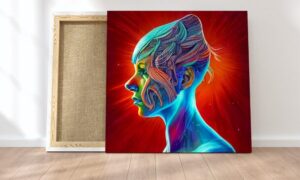Outsider art has gained recognition in recent years for its authenticity and diversity, and it continues to challenge the traditional boundaries of the art world. Outsider art, also known as art brut or self-taught art, is a non-traditional art that untrained artists create. It is a form of artistic expression not influenced by the mainstream art world and is often characterized by its emotional content, non-traditional techniques, and unique creative expression.
Characteristics of Outsider Art
Outsider Art has several defining characteristics that set it apart from mainstream art:
-
Raw and Untrained Approach
Outsider Art is characterized by its raw and untrained approach, often featuring rough brushwork, bold colors, and unconventional techniques. The artists who create Outsider Art often lack formal art training and are not bound by traditional artistic conventions, allowing them to experiment and create in their own unique way.
-
Unique and Unconventional Style
Outsider Art is also known for its unique and unconventional style. The artists who create Outsider Art often have a highly personal and distinctive approach to artmaking, creating works that are unlike anything else in the art world. This unique style often reflects the artist’s personality, cultural background, and life experiences.
-
Personal Expression
Outsider Art is created as a form of personal expression or therapy rather than as a means of commercial gain or artistic recognition. The artists who create Outsider Art are often driven by a deep need to express themselves and their emotions, using art as a means of communication and self-discovery.
-
Psychological and Emotional Themes
Outsider Art often deals with psychological and emotional themes, reflecting the artist’s innermost thoughts and feelings. The art created by Outsider artists is often deeply personal, reflecting issues such as mental illness, trauma, and spirituality.
Art Brut Vs. Outsider Art
Art Brut is a term coined by French artist Jean Dubuffet to describe art created by individuals outside the mainstream art world, often marginalized or institutionalized.
On the other hand, Outsider art is a broader term encompassing a wide range of non-traditional artistic expressions. It includes not only Art Brut but also other forms of non-mainstream art, such as folk art, naive art, and visionary art. Outsider art emphasizes the diversity and authenticity of non-traditional forms of artistic expression and challenges traditional artistic boundaries.
While Art Brut is a subset of outsider art, it is often used to refer specifically to the work of institutionalized or marginalized individuals, such as psychiatric patients or prisoners. Outsider art, on the other hand, encompasses a broader range of individuals and artistic styles and is often used to describe the work of self-taught or untrained artists.
Type of Art outsider art promotes
Outsider artists often create art that reflects their personal experiences and emotions, which may not align with mainstream cultural or societal norms. This departure from social conventions can be seen in the raw and unique masterpieces of art brut, the childlike simplicity of naive art, and the mystical themes of visionary art.
Marginal Art
“Marginal art” or “Art singulier” is a term used to describe art created by self-taught or non-mainstream artists operating outside the traditional art world.
Outsider art celebrates artistic expression as a means of empowerment for those marginalized in society. By departing from social conventions, outsider artists create a space for themselves to express their individuality and challenge the status quo.
Departing from social conventions is a crucial characteristic of outsider art that allows for a rich and varied artistic landscape that is not limited by traditional boundaries.
Self-Taught Art
Self-taught art is a term used to describe artists who have not had formal art training but have developed their own unique style and techniques. These artists have not followed the traditional path of attending art schools or apprenticeships but have learned through experimentation and exploration. Self-taught artists often work in isolation and may not have access to the resources and opportunities available to trained artists.
Outsider art also honors artists who exist on the fringes of society, often due to social, economic, or cultural factors. These artists may come from a variety of backgrounds and may have limited access to mainstream artistic resources, such as art education or art institutions. Outsider art celebrates the diversity and authenticity of non-traditional forms of artistic expression by showcasing the work of artists outside of traditional artistic circles.
Brut Art
Brut art is another term that is sometimes used to describe outsider art. The term “brut” is French for “raw,” “unpolished,” or “unrefined.” Brut artists create works that are often rough, unpolished, and characterized by a lack of attention to detail. The term was coined by French artist Jean Dubuffet in the 1940s, who believed that people create such art on the fringes of society who are not influenced by mainstream culture.
Naïve Art
Graffiti and naive art are also forms of outsider art that challenge traditional artistic boundaries. Naïve art is a term that is sometimes used interchangeably with outsider art. It is defined by the lack of formal training or education in art techniques and styles. Naïve art often incorporates childlike, primitive, or folk elements, with bold and simple shapes, bright colors, and imaginative compositions. Many outsider artists are considered naïve due to their unconventional art-making approaches.
Final Words
By celebrating the voices and perspectives of marginalized individuals and communities, these forms of art challenge traditional artistic boundaries and expand our appreciation for non-traditional forms of artistic expression. Through exhibitions, museums, online platforms, and artistic communities, we can promote and celebrate the work of untrained artists and support the voices of marginalized individuals and communities.



































